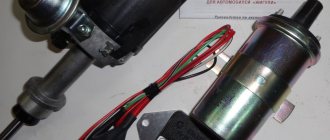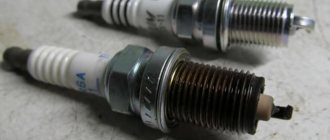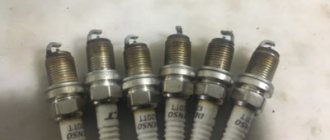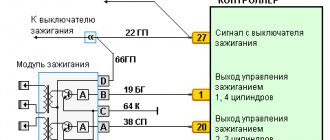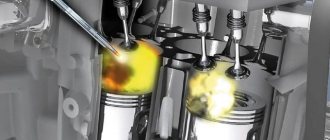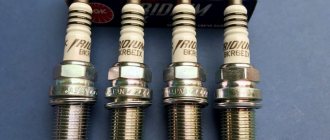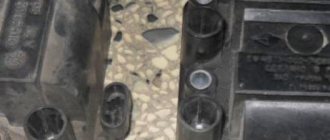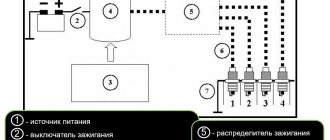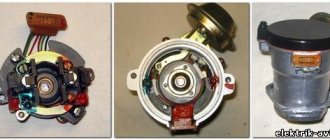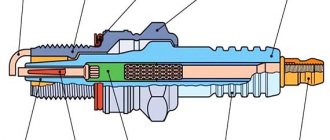The spark plug is the main element of the ignition system for igniting the fuel in the engine cylinders. The life of spark plugs is quite limited, which requires their periodic replacement. For different types of engines there are different spark plugs, which differ:
- by the number of electrodes and materials for their manufacture;
- by physical dimensions, heat rating, gaps between electrodes.
For this reason, car owners should know how spark plugs differ, how to choose the right spark plugs, and also which spark plugs are best for a particular engine. Read more in our article.
Spark plug heat number
The electrodes and the bottom of the spark plug are actually located in the combustion chamber. These parts can become very hot when the engine is running. If the heating is critical, glow ignition occurs (the working mixture ignites from contact with the hot electrodes of the spark plug, and not from a spark).
Taking into account this feature, candles differ in heat rating. Heat number is a parameter that determines the time of occurrence of glow ignition. Simply put, candles can be divided into “cold” and “hot”.
A low heat rating means that the spark plugs are “hot”, that is, glow ignition will occur on such a spark plug in a shorter period of time. A higher number will indicate that the plug is “cold”, meaning it will take longer for glow ignition to occur.
At the same time, it is important to select the best option for different engines and know which spark plugs the engine manufacturer recommends to install. For example, if the engine is forced, the compression ratio is high and the spark plugs are “hot”, there is a high probability of glow ignition occurring. “Cold” spark plugs are usually installed in such engines.”
However, if you put a “cold” spark plug in a regular engine with a low degree of boost, the spark plug will not warm up fully. The result is a violation of self-cleaning, rapid coking and failure of the spark plug.
Also, in order to understand which spark plug is better in terms of heat rating, it is necessary to take into account the operating features. If the car is constantly stuck in traffic jams and drives only at low speeds with a light load, the spark plugs may coke. In this case, you can put it a little hotter.
In the case when the car is actively used, the speed is constantly high, then installing “colder” spark plugs will reduce the risk of glow ignition, and high heating in such conditions will not lead to contamination of the spark plug electrodes.
Purpose and design of spark plugs
Automotive spark plugs are designed to ignite the fuel-air mixture in the combustion chamber of an internal combustion engine by producing a spark.
The design of automobile spark plugs is quite simple; it has remained virtually unchanged since 1902, the time of its invention by the famous German engineer Bosch. The main components of a candle are:
- contact pin;
- central electrode;
- side electrode;
- insulator;
- threaded metal frame (body);
- seals.
The spark plug works as follows: high voltage from the car's ignition coil is supplied at strictly defined points in time through the contact terminal of the spark plug to its central electrode. An electrical discharge occurs in the gap between the central and side electrodes, accompanied by sparking. It is, in fact, at this moment that the air-fuel mixture ignites in the engine combustion chamber.
This process is very clearly demonstrated in the animated and video materials of the article Design and principle of operation of the internal combustion engine.
It would seem that everything is simple: two electrodes and high voltage, but the difficulties lie in the technological nuances. The specificity of the operation of a spark plug is not only that it occurs using high-voltage equipment, but also that complex high-temperature transient processes occur both in the spark plug itself and in the environment (in other words, sharp changes in high temperatures). All these processes determine the choice and use of materials in its production.
We recommend: How to check the lambda probe sensor
Thus, the insulator, which serves to prevent breakdown of the high voltage supplied to the contact wire to the body parts (ground) of the engine, is made of high-strength technical ceramics. In addition to this function, the insulator performs the function of dissipating heat to the cylinder head.
Leakage currents are always present in high-voltage electrical circuits. Ring ribs on the outer surface of the insulator serve to increase resistance to leakage currents: they lengthen their path to the housing parts.
A high-voltage discharge is a source of radio interference for audio equipment turned on in the car. To suppress interference in some types of spark plugs, a resistor is installed in the middle part of the contact wire - a conductive mass made of glass material.
The contact terminal is usually made of a nickel alloy, and some manufacturers also contain a copper core for heat dissipation.
The same task - heat removal during operation - is performed by a metal body with a thread cut on it, and the external sealing ring, in addition to preventing the breakthrough of combustion products, also compensates for the difference in thermal conductivity of the cylinder head and the spark plug body.
Selection of spark plugs by gap
The spark plug gap is the distance between the center electrode and the side electrode. This gap differs on different spark plugs. It must be taken into account that if the gap is increased, spark breakdowns may occur (the spark is more powerful, but sparking may be skipped). If the gap is small, the spark will be more stable, but weak.
Previously, many car owners modified the spark plug gap themselves. Today, modern spark plugs for different engines have a fixed gap of 0.7 to 1.25 mm between the electrodes; changing it is not recommended. For this reason, the owner’s main task is to know which spark plugs to choose for a particular engine that are suitable for the gap.
By the way, during operation the electrodes gradually wear out and the gaps increase. In this case, you can go in two ways:
- modify the spark plug gap yourself;
- replace the spark plugs.
According to many experts, the second option is optimal, since a change in the gap of modern spark plugs indicates that their service life is almost exhausted. In other words, adjusting the gap is only a temporary measure and the spark plugs will still need to be changed soon.
Average spark plug life
Spark plug electrodes may differ in material of manufacture. We can highlight:
- nickel candles;
- iridium spark plugs;
- platinum candles.
Not only the efficiency of the work, but also the service life of the spark plugs directly depends on the material of the electrode. As a rule, spark plugs with a nickel central electrode last about 30 - 40 thousand km.
At the same time, platinum spark plugs last up to 70 thousand km, while iridium spark plugs can last up to 100 thousand km. and more. It can also be noted that spark plugs can have not one, but several side electrodes to increase reliability and increase service life.
At the same time, the above indicators are averaged. As practice shows, the use of medium and low quality fuel, short trips within the city, insufficient engine warming up and a number of other reasons lead to the fact that the average life of spark plugs is reduced by 30-40%.
This means that even the best spark plugs often need to be changed by 50-60 thousand km. mileage, while the cost of such spark plugs is quite high.
Main types of automotive spark plugs
Conventionally, the entire variety of spark plugs can be divided into three classes:
- Traditional two-electrode ones - their design is described in detail above - are the most common class;
- Multielectrode - in terms of scope of application they are inferior to traditional ones. However, they are quite popular among car enthusiasts;
- Torch and pre-chamber (or plasma-pre-chamber) - were first used in sports cars, and then in ordinary passenger cars, but their scope is currently limited by the level of confidence of motorists.
Even minor design changes seriously affect the performance of traditional two-electrode spark plugs. For example, on some models, a V-shaped notch is made on the surface of the central electrode or a U-shaped recess on the surface of the side electrode. Of course, these changes do not extend the life of the spark plug, but they do help increase the sparking area. In some types of engines, spark plugs with an elongated central electrode are used to improve the spark formation process.
Two-electrode spark plugs
In a large class of traditional two-electrode spark plugs, two subclasses are usually distinguished:
- Spark plugs in which the central electrode is made of homogeneous metal;
- Bimetallic - a coating of another metal is applied to the working surface of the central electrode, which improves the characteristics of the spark plug.
The main advantages of traditional candles are price and time-tested reliability.
We recommend: Why and how often do we change brake fluid?
The main disadvantages are limited service life, unstable spark formation parameters, low efficiency under cold engine start conditions.
The use of bimetallic compounds has become the main direction in improving two-electrode spark plugs. First of all, the changes affected the material of the core of the electrodes: if the material of homogeneous electrodes was nickel-containing steel, then the core of the new electrodes began to be made of copper.
This technology made it possible to improve heat removal from the working surface of the central electrode and, as a result, reduce the intensity of electrical erosion processes, and therefore increase the service life of the spark plug. This technology has improved the anti-carbon properties of the side electrode.
The next stage in the use of bimetallic compounds was the use of noble metals in the central electrode material: iridium and platinum (or rather, their alloys). platinum and iridium spark plugs appeared .
Iridium has high refractoriness (transition temperature to the liquid state is 2450°C) and increased resistance to electrochemical corrosion. Thanks to these properties, engineers were able to not only dramatically increase the durability of spark plugs, but also improve other characteristics. The fact is that due to the increased strength, it was possible to sharply (several times) reduce the diameter of the central electrode (to 0.4 mm), which in turn reduced the sparking voltage and increased its efficiency.
Platinum spark plugs also have characteristics similar to iridium ones. The main and, perhaps, the only drawback of platinum and iridium spark plugs is their high price. Perhaps maintenance can also be included here: while conventional candles can be mechanically cleaned of carbon deposits, platinum and iridium elements must be treated with much more care.
Multi-electrode spark plugs
In multi-electrode spark plugs, there are several side electrodes and they are usually located in a circle around the central electrode.
Sparking between the central and one of the side electrodes occurs randomly, and if any side electrode fails, its functions are “transferred” to the adjacent electrode. The main advantage of such spark plugs is a reduction in the load on the single side electrode compared to a traditional circuit and, accordingly, an increased service life compared to a two-electrode analogue.
In addition, in a two-electrode spark plug, the side electrode, due to its asymmetrical location (relative to the central electrode), screens part of the space behind it. Because of this, the spark formation zone is also asymmetrical with respect to the axis of the spark plug. With a multi-electrode design, this does not happen, and the fuel is burned more efficiently.
The main disadvantages of multi-electrode spark plugs are their relatively high cost and longer recovery (drying) time after cold starts.
Prechamber spark plugs
In prechamber spark plugs, the space around the central electrode is shaped like a rocket engine nozzle.
The high-voltage discharge between the electrodes is converted into a plasma clot, which, thanks to the geometry of the interelectrode space, is “shot” into the engine cylinders along with the combustion products. In this way, volumetric ignition of the fuel is formed, which, unlike traditional (rather point-based in this terminology) ignition, ensures more efficient and complete combustion.
In practice, prechamber spark plugs showed really good results when operating at high speeds, but at lower speeds they turned out to be worse than traditional ones. In addition, they are more expensive than previous classes. Therefore, the use of pre-chamber spark plugs in mass-market passenger cars is limited both technically and economically.
What spark plugs to put on an engine with HBO
After switching from gasoline to gas-cylinder equipment, car owners need to know whether there is a need to separately select spark plugs for gas, which spark plugs are installed on gas engines, etc.
It is important to consider the following:
- the spark plug gap for gas should be slightly smaller;
- “gas” plugs should be cooler compared to “gasoline” plugs.
The reason is that the mixture of air and gas burns slightly differently than gasoline. The combustion of gas is more powerful, that is, the octane number is higher, the combustion temperature is higher, and when gas is burned, there are fewer deposits in the chamber (the mixture burns more fully and cleaner).
We also recommend reading the article about the advantages and disadvantages of HBO. From this article you will learn about the pros and cons of gas equipment, as well as what you need to consider when installing gas equipment on a car.
It is easier to ignite the gas-air mixture, which reduces the gap between the electrodes. At the same time, a higher temperature in the combustion chamber when using gas increases the risk of glow ignition, which indicates the need to use “cold” spark plugs.
Let us also add that today car enthusiasts also have access to completely ready-made solutions. Spark plug manufacturers have brought to the market special gas spark plugs for engines with LPG. At the same time, “gas” candles are noticeably more expensive than regular ones.
At the same time, it is difficult to say which candles are better, correctly selected from ordinary ones or special ones for gas. The fact is that the quality of operation of the engine and spark plugs is also strongly influenced by fine settings of the gas equipment, the quality, type of installed gas equipment and a number of other features.
Origin of red plaque
This phenomenon is less common than the effects described above. Why are there red electrodes on some spark plugs?
- the tank is filled with low quality gasoline with additives that increase the octane number;
- a car enthusiast or a fuel supplier adds additives to gasoline, which contain a large amount of metals;
- the owner of the car installed spark plugs in the cylinders that did not match the heat rating.
The reasons for the reddish tint of spark plugs do not pose a direct threat to the power unit, but are harmful in the long term. Driving on low-quality gasoline with unknown additives a priori accelerates the wear of parts and components. Plus an increase in consumption arising from worsening combustion conditions of the mixture in the cylinders.
We recommend: How Brake Force Distribution (EBD) works
Operating a car with spark plugs that are “cooler” or “hotter” in terms of heat rating reduces engine power and significantly shortens the life of the elements. A characteristic sign of incorrectly selected spark plugs is a drop in crankshaft speed at idle and missed ignition cycles.
